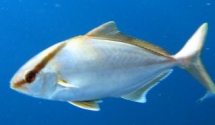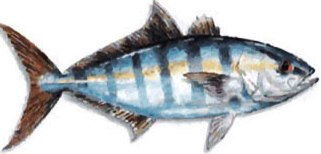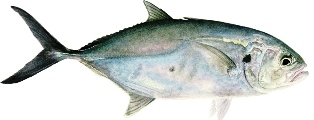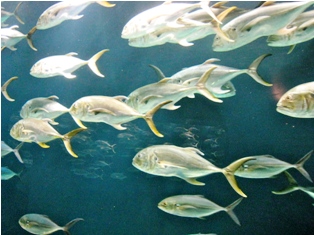Discover Florida Nature
It's time to explore the natural Florida


|
|
|
|
|
 Almaco
Jack
(Seriola rivoliana) Similar in appearance to the
greater amberjack, the Almaco Jack is characterized by a football shaped
body a thin forked tail with the body being darker on the top side with
a white underbelly and a dark line extending from the nose, thru the
eye, all the way down its flank. Its dorsal and anal fin it markedly
more curved and longer than that of the rest of his family. Almaco Jack
are common at 10-20 pounds. The Almoco Jack can reach a maximum length
of about 38 inches and maximum weight of 55 pounds. The almaco jack is
found more often in deeper, oceanic waters of the western Atlantic from
Massachusetts to Brazil, though rarely caught north of the Carolinas.
Almaco Jacks are also found through out the Gulf of Mexico. They are
more oceanic than the greater amberjack and occur at greater depths.
They tend to frequent reefs, rocks, wrecks and offshore oil and gas
platforms. Little is known of its life history, although it is expected
that the Almaco Jack would have reproductive, growth and feeding
characteristics similar to the greater amberjack. Other common names for
the Almaco Jack include Blackjack, Bar Jack, Amberjack, Almaco, and
Spanish Jack. When fishing for the Almaco Jack Fish live baitfish are
the best natural bait while, spoons, plugs, poppers and streamers are
the best artificial bait. Almaco
Jack
(Seriola rivoliana) Similar in appearance to the
greater amberjack, the Almaco Jack is characterized by a football shaped
body a thin forked tail with the body being darker on the top side with
a white underbelly and a dark line extending from the nose, thru the
eye, all the way down its flank. Its dorsal and anal fin it markedly
more curved and longer than that of the rest of his family. Almaco Jack
are common at 10-20 pounds. The Almoco Jack can reach a maximum length
of about 38 inches and maximum weight of 55 pounds. The almaco jack is
found more often in deeper, oceanic waters of the western Atlantic from
Massachusetts to Brazil, though rarely caught north of the Carolinas.
Almaco Jacks are also found through out the Gulf of Mexico. They are
more oceanic than the greater amberjack and occur at greater depths.
They tend to frequent reefs, rocks, wrecks and offshore oil and gas
platforms. Little is known of its life history, although it is expected
that the Almaco Jack would have reproductive, growth and feeding
characteristics similar to the greater amberjack. Other common names for
the Almaco Jack include Blackjack, Bar Jack, Amberjack, Almaco, and
Spanish Jack. When fishing for the Almaco Jack Fish live baitfish are
the best natural bait while, spoons, plugs, poppers and streamers are
the best artificial bait. Banded
Rudderfish
(Seriola zonata) The Banded Rudderfish is
characterized by a football shaped body that is silvery blue on top
fading to silver along its underside, like others in this family a
horizontal line begins at the mouth, goes thru the eye, and continues
down its flanks. There are vertical stripes extending down the side and
continuing up thru its fins. Banded rudderfish that are less than 11
inches long have dark band from eye to first dorsal fin and six
prominent bars on body. As the fish grows past 11 inches they lose their
bands and turn to a bluish, greenish, or brown color. The average weight
of the banded rudderfish is 3-6 pounds and it can reach over a foot in
length. The range of the banded rudderfish is the western Atlantic from
Nova Scotia, south to Brazil, including the Gulf of Mexico and the
Caribbean Sea. The adult fish prefers shallower water than other
amberjacks. The banded rudderfish can be found over hard bottom and
reefs, in deep inshore channels around structures, and in schools near
buoys oil rigs, at all depths. The Banded rudderfish feeds on other
smaller fish and shrimp. Banded
Rudderfish
(Seriola zonata) The Banded Rudderfish is
characterized by a football shaped body that is silvery blue on top
fading to silver along its underside, like others in this family a
horizontal line begins at the mouth, goes thru the eye, and continues
down its flanks. There are vertical stripes extending down the side and
continuing up thru its fins. Banded rudderfish that are less than 11
inches long have dark band from eye to first dorsal fin and six
prominent bars on body. As the fish grows past 11 inches they lose their
bands and turn to a bluish, greenish, or brown color. The average weight
of the banded rudderfish is 3-6 pounds and it can reach over a foot in
length. The range of the banded rudderfish is the western Atlantic from
Nova Scotia, south to Brazil, including the Gulf of Mexico and the
Caribbean Sea. The adult fish prefers shallower water than other
amberjacks. The banded rudderfish can be found over hard bottom and
reefs, in deep inshore channels around structures, and in schools near
buoys oil rigs, at all depths. The Banded rudderfish feeds on other
smaller fish and shrimp. Blue
Runner (Caranx crysos) The blue runner is extensively
distributed throughout the tropical and temperate waters of the Atlantic
Ocean, ranging widely along both the eastern American coastline and the
western African and European coastlines. From the Gulf of Mexico, the
blue runner distribution extends north along the U.S. coast and as far
north as Nova Scotia in Canada, also taking in several north-west
Atlantic islands. The blue runner is also present on several central
Atlantic islands, making its distribution Atlantic-wide. The blue runner
is distinguished from similar species by several morphological features,
including the extent of the upper jaw, gill raker count and lateral line
scale counts. The blue runner is known to reach a maximum length of 70
cm and 5.05 kg in weight, but is much more common below 35 cm. The
species inhabits both inshore and offshore environments, predominantly
over reefs, however it is known to congregate around large man made
offshore structures such as oil platforms. Juveniles tend to inhabit
shallower reef and lagoon waters, before moving to deeper waters as
adults. The blue runner is a schooling, predatory fish, predominantly
taking fish in inshore environments, as well as various crustaceans and
other invertebrates. Fish living offshore feed nearly exclusively on
zooplankton. The blue runner is a fast swimming predator which primarily
takes small benthic fishes as prey in inshore waters. Blue
Runner (Caranx crysos) The blue runner is extensively
distributed throughout the tropical and temperate waters of the Atlantic
Ocean, ranging widely along both the eastern American coastline and the
western African and European coastlines. From the Gulf of Mexico, the
blue runner distribution extends north along the U.S. coast and as far
north as Nova Scotia in Canada, also taking in several north-west
Atlantic islands. The blue runner is also present on several central
Atlantic islands, making its distribution Atlantic-wide. The blue runner
is distinguished from similar species by several morphological features,
including the extent of the upper jaw, gill raker count and lateral line
scale counts. The blue runner is known to reach a maximum length of 70
cm and 5.05 kg in weight, but is much more common below 35 cm. The
species inhabits both inshore and offshore environments, predominantly
over reefs, however it is known to congregate around large man made
offshore structures such as oil platforms. Juveniles tend to inhabit
shallower reef and lagoon waters, before moving to deeper waters as
adults. The blue runner is a schooling, predatory fish, predominantly
taking fish in inshore environments, as well as various crustaceans and
other invertebrates. Fish living offshore feed nearly exclusively on
zooplankton. The blue runner is a fast swimming predator which primarily
takes small benthic fishes as prey in inshore waters.  Crevalle
Jack (Caranx hippos) The crevalle jack is found in the
Gulf of Mexico and up the coast of Florida including estuaries and
rivers. The juveniles and smaller fish are often seen up the shallow
parts of rivers with brackish waters and as they get older and larger
the fish tend to be more on the continental shelf in the deeper waters
inhabiting areas around reefs and other structures. The crevalle jack is
fished commercially throughout the year in southwest Florida and also in
the Gulf of Mexico through the spring, summer and fall. It is also a
very popular sport fish and is the most common large jack caught off the
west coast of Florida in the Gulf of Mexico. Crevalle jack’s color
varies from a greenish-bluish or bluish-black on top to silvery white or
yellowish underneath. This coloration helps this fish blend in with the
water hiding it from predators above. The same coloration also helps it
blend with the sunlight to hide from predators below. The pectoral fins
have oval dark spot on and the juveniles also have 5 dark bars on their
bodies which remain present until the juvenile fish reaches a size of
6.46 inches. The maximum size of a crevalle jack is just under 40 inches
and 55 pounds. However those commonly seen off the coast of Florida are
normally 24 inches. The crevalle jack has large eyes and has a body
depth of about three times its very distinctive fork length. The adult
crevalle jack will prey upon a whole variety of smaller fish and will
also eat crustaceans and shrimps, while the juveniles feed on small fish
and any crustaceans they come across. Crevalle
Jack (Caranx hippos) The crevalle jack is found in the
Gulf of Mexico and up the coast of Florida including estuaries and
rivers. The juveniles and smaller fish are often seen up the shallow
parts of rivers with brackish waters and as they get older and larger
the fish tend to be more on the continental shelf in the deeper waters
inhabiting areas around reefs and other structures. The crevalle jack is
fished commercially throughout the year in southwest Florida and also in
the Gulf of Mexico through the spring, summer and fall. It is also a
very popular sport fish and is the most common large jack caught off the
west coast of Florida in the Gulf of Mexico. Crevalle jack’s color
varies from a greenish-bluish or bluish-black on top to silvery white or
yellowish underneath. This coloration helps this fish blend in with the
water hiding it from predators above. The same coloration also helps it
blend with the sunlight to hide from predators below. The pectoral fins
have oval dark spot on and the juveniles also have 5 dark bars on their
bodies which remain present until the juvenile fish reaches a size of
6.46 inches. The maximum size of a crevalle jack is just under 40 inches
and 55 pounds. However those commonly seen off the coast of Florida are
normally 24 inches. The crevalle jack has large eyes and has a body
depth of about three times its very distinctive fork length. The adult
crevalle jack will prey upon a whole variety of smaller fish and will
also eat crustaceans and shrimps, while the juveniles feed on small fish
and any crustaceans they come across.
|
|
|
Advertise | Privacy Statement | Dog Encyclopedia | Video |Contact | Alaska Nature |
|